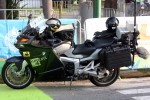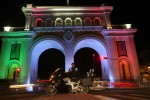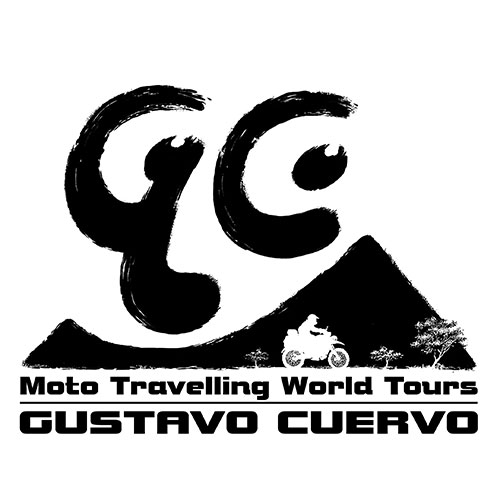 Throughout the second half of October, the 16th Pan American Games thrilled millions of sports fans throughout the world, as around 6,000 athletes from over 40 nations competed for glory in Guadalajara in Mexico. BMW bikes were among the action in the marathon, triathlon, race walking and cycling competitions, with Gustavo Cuervo and his colleagues using K 1200 GTs to film and transmit television pictures worldwide. The Spanish rider speaks exclusively to BMW Motorrad about how the GT performed at the Games.
Throughout the second half of October, the 16th Pan American Games thrilled millions of sports fans throughout the world, as around 6,000 athletes from over 40 nations competed for glory in Guadalajara in Mexico. BMW bikes were among the action in the marathon, triathlon, race walking and cycling competitions, with Gustavo Cuervo and his colleagues using K 1200 GTs to film and transmit television pictures worldwide. The Spanish rider speaks exclusively to BMW Motorrad about how the GT performed at the Games.
 What are the qualities a motorcycle needs for this specialised role?
What are the qualities a motorcycle needs for this specialised role?
There are many technical characteristics a motorcycle must have to perform TV retransmission work. For a start, the engine must have high torque available throughout its range but especially at low revs. This gives greater capacity for smooth passing without pulling or jumping. It also needs to have power available in the entire speed range, because sometimes there are gradients of more than 20% in bicycle races. Powerful brakes with ABS are a necessity in order to stop quickly to avoid colliding with falling athletes or spectators suddenly invading the road.
The ideal motorcycle must also have a high load capacity so that it can transport all the technical equipment as well as two people (rider and cameraman) with enough space for them to both work comfortably and safely. It must have high stability at any speed, so there is no camera-shake from slow speed close-up shots to filming with great precision in the very fast descents with cyclists. The engine also needs enough electrical energy to maintain the delicate technical equipment of TV. Naturally, emission levels need to be as low as possible because the bikes are very close to the athletes and should not pollute the air they breathe.
 How were the K 1200 GTs modified to carry all the extra equipment?
How were the K 1200 GTs modified to carry all the extra equipment?
The bikes carry special media transport hard cases for the technical equipment. Their dimensions are larger than the standard cases and are packed full of electronic equipment. There is also a central rear ‘box’ for transporting the auxiliary battery and TV transmitter. There are also four mirrors on the bikes – the two originals and two extras on the handlebars in order to give a full field of vision behind us. The headlights are blocked off so they do not interfere with the television pictures when the bikes are captured on camera close to the athletes.
Are there special foot-pegs or rails for the cameraman to hold?
The camera operator has toothed metal pegs, as used in motocross, to avoid their feet slipping when they are standing up filming. There are also padded supports on the front of the side cases to support their legs.
Are there any engine modifications for the extra battery power required or for engine cooling?
 The engine needs no modifications or changes in the power system. The capacity of the generator is decent and we just need to keep the revs above 1,500 rpm to power the three additional batteries that maintain stable tension in the technical equipment. There are no changes in the cooling system either. We are discussing with engineers the introduction of additional fans, but it is difficult due to the limited space available and the increase in power consumption involved. The most important change is in the gearbox, where second and third gears are shorter to provide more torque at low and medium speeds. These gears are specially fabricated by a German specialist. Gear changes are a little noisy but the bikes work so much better in their role with this modification.
The engine needs no modifications or changes in the power system. The capacity of the generator is decent and we just need to keep the revs above 1,500 rpm to power the three additional batteries that maintain stable tension in the technical equipment. There are no changes in the cooling system either. We are discussing with engineers the introduction of additional fans, but it is difficult due to the limited space available and the increase in power consumption involved. The most important change is in the gearbox, where second and third gears are shorter to provide more torque at low and medium speeds. These gears are specially fabricated by a German specialist. Gear changes are a little noisy but the bikes work so much better in their role with this modification.
Do you spend as much time looking in your mirrors as looking in front of you?
Correct. You need to see many things in your mirrors – not only who is leading the race, but also what is happening even further behind, where runners, athletes or cyclists will be making their own race plans for progression to the front. We need a vast experience and knowledge of each sport to anticipate what might happen and put the bike with the cameraman in the best place to catch all the action – and all the time without disturbing any of the race participants.
It takes experience to get it right. Our bikes should be in the best place to get the best pictures for spectators to watch on their TVs, but they must also be ‘invisible’ to the athletes and not get in the way of any of the competitions taking place. Cycling, triathlon and race walking are the only sports that allow mobile TV cameras inside the field, so it’s a great responsibility for us.
Can you speak directly to the camera operator by radio, or does he have to shout?
The rider and cameraman shouldn’t speak aloud to one another because the bike is equipped with external microphones to capture the ambient sound. Communications are very complex in a live broadcast. We have an internal radio system in which we receive communication from the driver/cameraman; orders from the TV programme director; notification from the chief technician of any problems in the transmission; the radio of the event organisers [only in cycle racing] and commentary of the live broadcast programme. These five channels are transmitted to a loudspeaker built into the motorcycle helmet and a display on the dash indicates the priority. There’s a lot going on – both in your head and around you!
 Has the technology for transmitting live pictures changed over the years?
Has the technology for transmitting live pictures changed over the years?
The bikes are equipped with the latest HD digital technology. This allows smaller, lighter equipment, which lasts longer and gives a cleaner transmission than the old analogue equipment. Years ago things were much heavier and offered less technical performance but now the bikes can transmit very large amounts of information – images, sounds, speeds, road condition data, temperature etc – from different channels. Digital technology has allowed us to increasingly expand the information offered to enrich the transmissions, but it is a great technological challenge at the same time, as there is a large accumulation of complex electronic systems on the bikes, all of which have to be completely isolated and work in all kinds of weather and climactic conditions.
 How do you take refreshments while covering long events?
How do you take refreshments while covering long events?
During the long retransmissions, regular hydration is important, especially in hot weather. Certain events, such as race walking, mean that speeds are too slow to dissipate the heat generated by the engine, so the temperature around the motorcycle is very high. Also, in the road race cycling competitions we are riding continuously for more than five hours, so we have to consume food and sports drinks while on the move.
You’ve used the BMW Airflow helmet before. Does this really make a difference in the heat?
The Airflow helmet offers excellent characteristics for wearers who are working for several hours in high temperatures. There is a noticeable difference if you use a helmet that does not have the extensive ventilation system that the Airflow provides.
How do you get in the best positions for pictures, without getting in the way of the competitors?
Finding the best position to capture the images without interfering in the competition is something that requires constant attention, good knowledge of the sport and some sixth sense. Experience is essential and we must have a thousand eyes and ears to anticipate all situation.
Do you think the GT has the potential to be as good as the LT you used for so many years?
The BMW GT has great potential as the ideal bike to replace the veteran K 1100 LT that we have used for years. It has a much more powerful engine, is smoother and the additional torque increases the capacity of the bike for the job. The Pan American Games were the latest step in the development of the GT for this purpose and we tested them under all kinds of conditions – human and technical – which now gives us an idea of how the K 1300 GT model will work for us next year in London for the Olympic Games.
To watch some video footage of Gustavo and the team in Mexico at the recent Pan American games, click here
[flash http://www.youtube.com/watch?v=rejbhCdWCco w=450 h=400]


